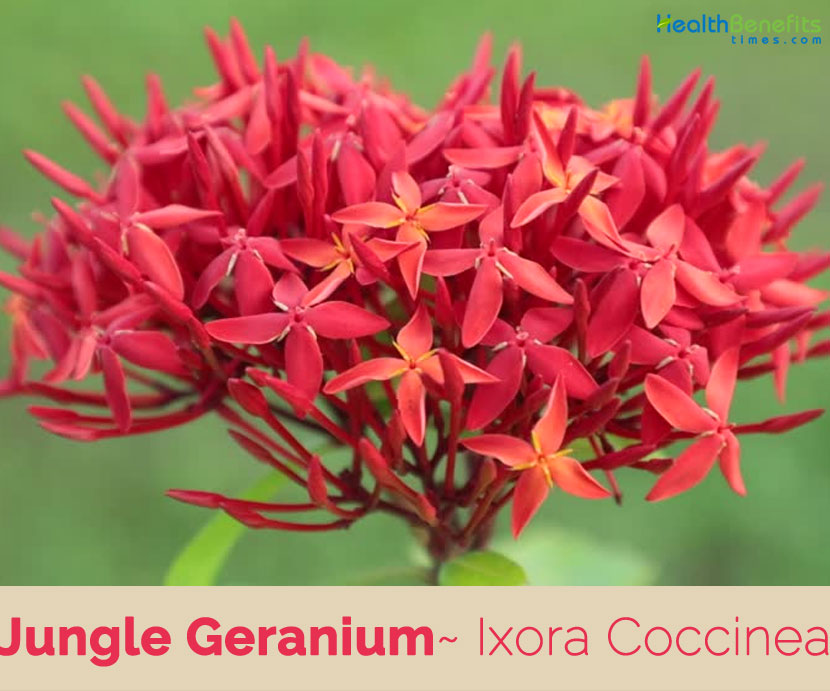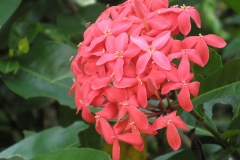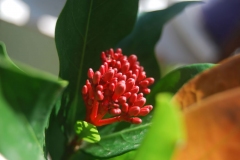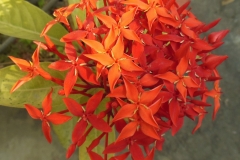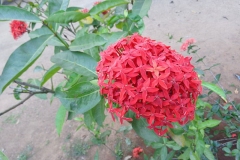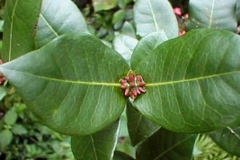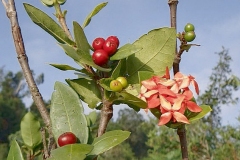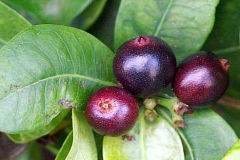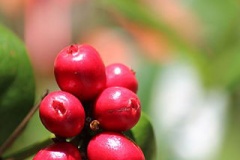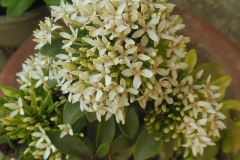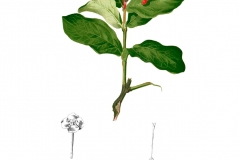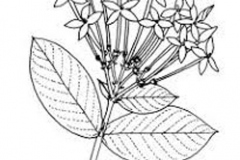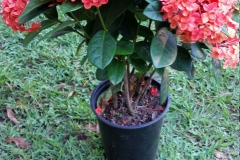| Jungle Geranium Quick Facts | |
|---|---|
| Name: | Jungle Geranium |
| Scientific Name: | Ixora Coccinea |
| Origin | India and Sri Lanka and widely cultivated in Indonesia, Malaysia, Philippines, Vietnam, Cambodia, Laos and Thailand |
| Colors | Green when young turning to dark red or purplish-black as they matures |
| Shapes | Globose berry, reddish-black, 0.5 cm across, with persistent calyx |
| Taste | Bitter, Acrid, Sweet |
| Health benefits | Heals the wounds, Body pain, Hemorrhoid medicine, Dysentery medicine, Cramps in the calves, Maintain the health of the uterus |
| Name | Jungle Geranium |
|---|---|
| Scientific Name | Ixora Coccinea |
| Native | India and Sri Lanka, widely cultivated in Indonesia, Malaysia, Philippines, Vietnam, Cambodia, Laos and Thailand |
| Common Names | Burning Love, Flame of the Woods, Ixora, Jungle Flame, Jungle Geranium, Passionate Love, Scarlet Ixora, Scarlet Jungle Flame, Sacred Ixora, Shiva’s Flame, West Indian Jasmine, jungle flame ixora, flame of the forest, red ixora, needle flower, flame flower, indian ixora |
| Name in Other Languages | Arabic: Iiksurat qarmazia (إكسورة قرمزية) Assamese: Rangan, Ronga-rangan, Rogiyal-phul Bengali: Rangan, Rangana, Rookmini, Raṅgana (রঙ্গন) Brazil: Iroxa Burmese: Pan Sayeik, Poan~Na. Rait, Ponna Yeik, Pone-Na-Yeik, Pundarik Cambodia: Kam ron tea Chinese: Long Chuan Hua Czech: Ixora Šarlatová Danish: Ildkugle, Ixora Dutch: Faja Lobi, Faya Lobi English: Flame-of-the-woods, Jungle-geranium, Scarlet jungle flame, burning love, flame of the forest, ixora, red ixora, scarlet ixora, needle flower, sacred ixora, Jungle flame, jungle flame ixora, flame flower, indian ixora Estonian: Punane Iksoora Finnish: Korallitähtikukka French: Ixora Ecarlate German: Ixore, Scharlachrote Iora, Scharlachroter Flammenbusch, indischer Korallenstrauch Hindi: Rajana, Ranjan, Rugmini (रुगमिनी), Bandhu-jivaka, bandhuka, cetti, cheththi, paranti, rajana, saoltua, schetti, sveta paranti, tecci, tetti, thetti chelthi, velutta cetti Indonesia: Kembang Santen Merah, Soka Merah, Soka Bereum, Rugmini, Kembang asoka Kampuchea: Kam Ron Tea Kannada: Gudda Daasala, Guddedasal, Gudde Dosal, Gurugudu, Holedaasala, Kaepala, Kapala Hoo, Kempu Kaepala, Kempugundu Hoo, Kempukepala, Kempulagida, Kepala, Keppulagida, Kepula, Kepuladai, Kevala, Kevala Gida, Kisagaara Hoo, Kisgara, Kiskar, Kiskara, Kissara, Kissargida, Kisu Kaare, Kisukaare, Kisukare, Kusumaale, Maale Gida, Maale Hoo, Maalehoo Gida, Haḷadi kisukāre (ಹಳದಿ ಕಿಸುಕಾರೆ) Konkani: Patkali, Podkali Malay: Pechah priok Malayalam: Cekki, Cetti (ചെത്തി), Chekki, Chethi, Chetti, Kattutechi, Schetti, Shekki, Shetti, Tecci, Techi, Tetti, Thechhi, Thechi, Thetti Marathi: Bakali, Bakora, Padkali, Pankul, Pendgul, Pendkul, Pentgul, Pitkuli, pendagul (पेंडगूळ) Myanmar: Pan-thawka , pan-zayeik , pon-na-yeik Oriya: Bondhuko, Romoniphulo, Ruktuka Paluan: Kerdeu Ra Ngebard Panama: Cache De Tore, Jazmin De Coral Peru: Buquet de novia Philippines: Tangpupo (Bisaya), Santan, Santan-Pula, santan, dwarf santan Polish: Iksora szkarłatna Portuguese: Amor Ardent, Flor De Coral, Ixora, Ixora Coral, Cruz De Malta, Ixora Coral, Ixora Vermelha, Siderodendro Sanskrit: Bandhujivaka, Bandhuka (बन्धूक), Bandhujivaka Parali, Binduka, Ishwara, Parali, Paranti, Patali, Raktaka, Raktala, ishwara (ईश्वर) Spanish: Amor Ardiente, Bola De Coral, Coral, Corallilo, Cruz De Malta, Equisósea, Ixora, Jazmin Del Diablo, Santa Rita Sri Lanka: Rathmal, Vedchi, Ratambala, Bandhuka Swedish: Eldboll Tagalog: Ixora Tamil: Attimankicacceti, Attimankicam, Cetarakacceti, Cetarakam, Cetaram, Cetti-Cetti, Cheddi, Cinturacceti, Cinturam, Citaram, Cuvetaki, Cuvetakicceti, Erinakai, Koranpoo, Koran, Koranpu, Kullai, Mayilai, Sedaram, Setti, Sinduram, Tecci, Telli, Vedcci, Vedji, Vellaivetci, Vellaivetcippucceti, Velvetci, Verchi, Vetchi, Vetci, Vitchie, Vitci (வெட்சி) Telegu: Bandhuca, Bandhujeevakamu, Bandhujeevamu, Bandhujivakamu, Bandhujivamu, Bandhukamu, Koranam, Korani, Mankana, Manmadhabana, Nuru Varahalu, Manmadhabāṇaṁ (మనమధబానం) Manmadibanum, Manmathabanamu, Raama Bhanamu, Rama Banamu (రామబాణము), Nūru varahālu – erupu (నూరు వరహాలు – ఎరుపు) Thailand: Khem Baan, Khem Nuu, Khem Farang Tonga: Huni kula Vietnam: Mẫu Đơn, Cây Đơn Đỏ, Trang Son, Mẫu đơn đỏ, bông trang dỏ, dơn dỏ, dun trung quoc, dun do |
| Plant Growth Habit | Small, dense, multi branched, glabrous evergreen shrub |
| Soil | Thrives best in light-texture, well-drained, fertile, acid soils with pH 5.0–5.5 and rich in organic matter. It does best in full sun but tolerates partial shading. Ixora is mildly tolerant of salt sprays but is intolerant of highly alkaline soils becoming chlorotic |
| Plant Size | 4–6 ft. (1.2–1.8 m) in height, but capable of reaching up to 12 ft. (3.7 m) high |
| Stem | Herbaceous, aerial, erect, branched, cylindrical, differentiating into nodes and internodes, green |
| Leaf | Sessile, opposite, decussate, simple, leathery, glossy green, ovate to obovate with cordate or obtuse bases, apiculate tips, 3.5–8 cm long and 2.5–3.5 cm wide |
| Flower | Flowers are bisexual, actinomorphic, tetramerous, epigynous. Calyx aposepalous, the sepals 4, ovate, reddish. Corolla sympetalous, 3–4.5 cm long, 4-lobed, tubular-rotate, the lobes 4, lanceolate to ovate, pointed, reddish, pink or yellow |
| Fruit Shape & Size | Globose berry, reddish-black, 0.5 cm across, with persistent calyx |
| Fruit Color | Green turning to dark red or purplish-black as they matures |
| Propagation | Vigorous growing tip cuttings |
| Plant parts used | Flowers, leaves, roots, bark and the stem |
| Available Forms | Decoction, tincture, poultice or dried and powdered |
| Taste | Bitter, Acrid, Sweet |
| Culinry Uses |
|
| Health Benefits |
|
Plant Description
Jungle Geranium is a small, dense, multi branched, glabrous evergreen shrub that normally grows about 4–6 ft. (1.2–1.8 m) in height, but capable of reaching up to 12 ft. (3.7 m) high. It has a rounded form, with a spread that may exceed its height. The plant thrives best in light-texture, well-drained, fertile, acid soils with pH 5.0–5.5 and rich in organic matter. It does best in full sun but tolerates partial shading. Ixora is mildly tolerant of salt sprays but is intolerant of highly alkaline soils becoming chlorotic. Stem is herbaceous, green, and aerial, erect, branched, cylindrical, and differentiating into nodes and internodes.
Leaves
Leaves are sessile, opposite, decussate, simple, leathery, glossy green, ovate to obovate with cordate or obtuse bases, apiculate tips. They are 3.5–8 cm long and 2.5–3.5 cm wide, margin entire, with interpetiolar, deltoid stipules. Leaves are bronzy when young, later turning to a gleaming dark green.
| Leaf arrangement | Whorled |
| Leaf type | Simple |
| Leaf margin | Entire |
| Leaf shape | Ovate |
| Leaf venation | Pinnate |
| Leaf type and persistence | Evergreen |
| Leaf blade length | 2 to 4 inches |
| Leaf color | Green |
| Fall color | No fall color change |
| Fall characteristic | Not showy |
Flower
Flowers borne in dense terminal, dichasial cymose heads, cymules 3-flowered, occasionally 2–5 flowered. Flowers are bisexual, actinomorphic, tetramerous and epigynous. Calyx is aposepalous, the sepals 4 are ovate, reddish. Corolla is sympetalous, 3–4.5 cm long, 4-lobed, tubular-rotate, the lobes 4, lanceolate to ovate, pointed, reddish, pink or yellow. Androecium is polyandrous, stamens 4, exerted. Ovary is 2-loculed, syncarpous, style filiform, stigma bifid, ellipsoid and exerted. The colors depending on cultivars may be white, red, orange, pink or yellow. Jungle Geranium flowers bloom all year round.
| Flower color | Red; yellow; pink; white; orange |
| Flower characteristic | Year-round flowering |
Fruits
Fertile flowers are followed by fleshy globose berry that is 0.5 cm across, with persistent calyx. Fruits are initially green turning to dark red or purplish-black. When fully developed, there are two seeds per fruit. However, usually one develops and one aborts in Puerto Rican plants.
| Fruit shape | Round |
| Fruit length | Less than .5 inch |
| Fruit cover | Fleshy |
| Fruit color | Purple |
| Fruit characteristic | Inconspicuous and not showy |
Health benefits of Jungle Geranium
Jungle Geranium flower has several substances that can cure some diseases. Diseases that can be cured are as follows
1. Heals the wounds
Jungle Geranium flower can be used as a wound healer. This plant consists of natural compounds that can help speed up the process of wound healing in the body. The trick is also quite easy, pound the plant and paste it on the wound. However, since this is the traditional way, then you have to be careful in using it, especially in terms of cleanliness so that the wound does not get worse due to bacteria.
2. Body pain
If you are experiencing body pain, you should try to consume boiled water from this plant. In addition, you can also massage on areas of pain and consume drugs to relieve pain, if the pain does not heal.
3. Hemorrhoid medicine
One characteristic of hemorrhoids is a lump in the anus that feels pain when the patient is sitting or while dispose of feces. In severe conditions, the lump may rupture and bleed. At a severe level, hemorrhoids can only be cured by way of surgery. Therefore, ordinary medication is not possible to do. However, if the hemorrhoids are still at a mild level, you can consume Jungle Geranium flower.
4. Dysentery medicine
In addition to being used as a hemorrhoids drug, Jungle Geranium flower can also be used as a dysentery medicine. Because this plant consists of a lot of active compounds that are used to cure various diseases, one of them is dysentery.
5. Cramps in the calves
Jungle Geranium flower also serves as an analgesic, which can eliminate pain. Of course, this is very useful to overcome the cramps in the calf naturally. In addition to using this plant, you can also apply a balm and massage it slowly. Or you can also do a light stretch to relieve cramps.
6. Maintain the health of the uterus
Jungle Geranium flower also helps to keep the uterus healthy. Because the womb is one of the important organs that a woman has in order to obtain offspring.
Traditional uses and benefits of Jungle Geranium
- Flowers, leaves, stem and roots are used to treat various ailments in the Indian traditional system of medicine, the Ayurveda, and also in various folk medicines and in Southeast Asia.
- Decoction of leaves has been used for wounds and skin ulcers.
- Poultice fresh leaves and stems have been used for sprains, eczema, boils and bruises.
- Bark has been used for bloodshot eyes.
- Diluted root tincture has been used for mouthwash and gargle for sore throat.
- Root decoction have been administered as a sedative in the treatment of nausea, hiccups and loss of appetite, to stimulate gastric secretion, to act as cholagogue, to control dysenteric diarrhea and to clarify urine.
- Moistened powdered roots are applied externally to sores and chronic ulcers.
- In Sri Lanka traditional medicine, a decoction of Jungle Geranium flowers is used for haemophytis, acute bronchitis and dysmenorrhea.
- Flowers and bark are used on reddened eyes and outbreaks in children.
- Root decoction is recommended for dysentery, loss of appetite, fever and gonorrhea and as a sedative for hiccups and nausea.
- Leaves are used for dermatological disorders.
- In the Philippines, decoction of roots is used to treat nausea, hiccups and anorexia.
- Powered roots are used for sores and chronic ulcers.
- Flowers have been used for dysentery, leucorrhoea, bloodshot eyes.
- Flower decoction has been used to treat hypertension, amenorrhea and irregular menstruation, hemoptysis and catarrhal bronchitis.
- Root decoction is used to clarify the urine and used as an analgesic, sedative, diuretic and anti-dysenteric in Indochina.
- Flowers have similar but weaker properties and fresh leaves and stems are used as poultice for sprains, eczema, boils and contusions.
- Root is used as a stomachic, for acute dysentery, loss of appetite, chronic ulcers, and applied on sores in India.
- Flower is used for dysentery, catarrhal bronchitis, and leucorrhea.
- Decoction of the roots is used as a sedative in the treatment of nausea, hiccups and loss of appetite in Philippines.
- Flowers are used in the treatment of dysentery, leucorrhoea and dysmenorrhea.
- Decoction of the flowers is recommended to treat Haemoptysis and catarrhal bronchitis.
- Decoction of the root is used in folk medicine as an analgesic, sedative, diuretic and anti-dysenteric.
- Roots or flowers are used as anti-inflammatory and anti-diarrheal drugs, astringent, tranquilizer and appetite stimulant in Thailand.
- Flowers are also used as cholagogue and stimulant of digestive enzyme secretion.
- In India the roots are reported to possess sedative and stomachic properties and are used against hiccups, fever, and gonorrhea, loss of appetite, diarrhea and dysentery.
- They are reported to stimulate gastric secretions and bile and to provide relief in abdominal pains.
- Roots possess astringent and antiseptic properties and are applied to sores and chronic ulcers, and also to treat headache.
- Decoction of the flowers or the bark is used as a lotion against eye troubles, sores and ulcers.
- Leaves are used to treat diarrhea, it is widely cultivated as an ornamental.
- Flower infusion is used as bathing for infants to protect against skin disease.
- It is used as sedative for hiccups, loss of appetite, fever and gonorrhea.
- It is also used for dysentery, hemoptysis, catarrhal bronchitis, and dysmenorrhea.
Ayurvedic Health benefits of Jungle Geranium
- Skin Diseases: Chop flowers of Jungle Geranium. Boil them in Coconut oil. Use it over infected or damaged Skin.
- Leucorrhoea: Crush flowers of Jungle Geranium to make paste. Add 1 tsp. of it in 1 glass of Buttermilk. Have it twice a day.
- Fever: Make a decoction with flowers of Jungle Geranium. Have 20 ml of it once a day.
- Dysentery: Grind 100 g dried roots of Jungle Geranium with 50 g Black Pepper. Consume it by adding 20 g of the powder in Buttermilk. Have it twice a day.
- Diarrhea: Take 500 g root bark of Jungle Geranium and 300 g Long Pepper. Grind them to make powder. Take 2 g of it twice a day with lukewarm water.
Other Facts
- In warm climates, Ixora with flowers in various shades of red, pink, orange, yellow or white is popularly and widely planted as an ornamental for hedges and screens, foundation plantings and mass plantings in flowering beds or grown as a specimen shrub or small tree, in a container in the patio or poolside and in pots around the outside of houses.
- Dwarf or miniature varieties are also popular.
- Jungle Geranium flowers are also cut and used for flower arrangements.
- It is the national flower of Suriname.
References:
https://www.itis.gov/servlet/SingleRpt/SingleRpt?search_topic=TSN&search_value=35200#null
http://www.hear.org/pier/species/ixora_coccinea.htm
https://npgsweb.ars-grin.gov/gringlobal/taxonomydetail.aspx?id=20580
https://www.cabi.org/isc/datasheet/29175
http://www.missouribotanicalgarden.org/PlantFinder/PlantFinderDetails.aspx?kempercode=e515
https://plants.usda.gov/core/profile?symbol=IXCO
https://en.wikipedia.org/wiki/Ixora_coccinea
https://npgstest2.agron.iastate.edu/gringlobal/taxonomydetail?id=20580
https://www.wikidata.org/wiki/Q1856114
http://www.theplantlist.org/tpl1.1/record/kew-103356
https://edis.ifas.ufl.edu/fp291
https://gd.eppo.int/taxon/IXRCO
https://indiabiodiversity.org/species/show/244744
https://uses.plantnet-project.org/en/Ixora_coccinea_(PROSEA)
https://www.monaconatureencyclopedia.com/ixora-coccinea/?lang=en
http://www.stuartxchange.org/Santan.html
http://citeseerx.ist.psu.edu/viewdoc/download?rep=rep1&type=pdf&doi=10.1.1.214.2713
http://tropical.theferns.info/viewtropical.php?id=Ixora+coccinea
http://www.flowersofindia.net/catalog/slides/Ixora%20red.html
https://bie.ala.org.au/species/https://id.biodiversity.org.au/node/apni/2911526
https://davesgarden.com/guides/pf/go/161206/#b


